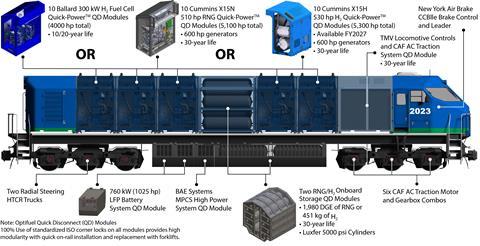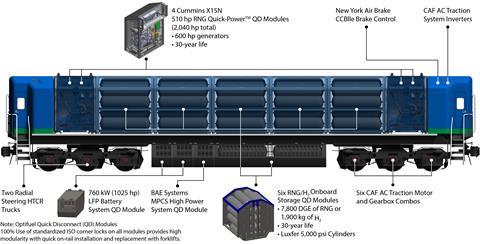
USA: Plans have been unveiled for the development and testing of a prototype main line freight locomotive with a powered tender, which will be fuelled by renewable natural gas.
RNG is a purified biogas that can be used interchangeably with conventional natural gas.

OptiFuel Systems is to act as technical lead, working with GTI Energy and supported by a grant from the federal Department of Energy. Other project partners included Cummins, BAE Systems, Luxfer Gas Cylinders, TMV Control Systems, Ensco, CAF Group, New York Air Brake and Marmon Rail company Powerhouse.
The Total-Zero RNG loco would be equipped with gas-fuelled Cummins engines using OptiFuel’s Quick-Power technology and have a continuous rating of 5 100 hp. A battery pack would capture regenerated braking energy to boost performance and give a peak power output of 5 600 hp. The powered tender would be rated at 2 500 hp.
OptiFuel said the locomotive would be a ‘near-term, low-risk, affordable’ alternative to diesel locos, offering zero well-to-wheel nitrogen oxide and particulate emissions.
The prototype is expected to be ready for a year of pre-production testing at the Federal Railroad Administration’s Transportation Technology Center from January 2025. This would be followed by a two-year, 1·6 million km test programme, with 10 pre-production locomotives and five tenders operating around the USA. Subject to successful completion, the partners anticipate that full scale production could begin in 2028.
The locomotives would be assembled using low-cost high-volume components, using quick-disconnect modules fitted with standardised ISO corner locks.
The cost of a single locomotive is estimated at around $5·5m, with purchase or leasing options envisaged. The capital cost is expected to be offset by ‘significant’ savings in annual operating costs, including lower fuel and maintenance costs, as well as higher reliability.
‘Preferred path to zero emission’

Announcing the project on January 11, OptiFuel President Scott Myers said the company understood the strengths and weaknesses of battery-electric and hydrogen fuel cell hybrid locomotives, having designed and built fuel cell, hydrogen storage and battery modules for a shunting loco used by Sierra Northern Railway.
‘However, we now believe that RNG is the preferred path to zero emission line-haul locomotives and tenders, due to the physics of energy storage, overall operating cost, operating risk, fuel availability and cost over the next 20 years.
‘A 4 500 hp line-haul locomotive requires continuous high power for extended hours, something that neither battery-electric nor hydrogen fuel cell hybrid line-haul locomotive solutions will be able to do.’

















